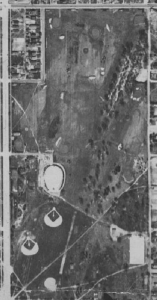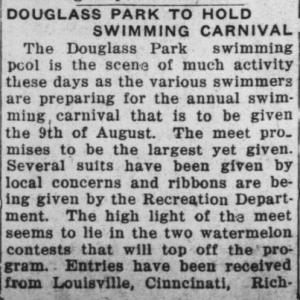by Jared Meunier
Visit Indy recently proposed to build beaches along the White River, an idea taken from the Parisian river Seine. The White River has been used in the past for recreational swimming. However, since the White River contains so much e. coli bacteria (often 100 more times than is safe for swimming), this would clearly be a cause of concern for most citizens looking for safe and clean places to swim such as public pools.

A 1937 aerial view of Douglass Park includes the swimming pool (left center, above the two baseball diamonds) as well as the segregated golf links.
For much of the 20th century Indianapolis’ only public African-American swimming pool was Douglass Park. Built in 1921, Douglass Park was a center for many of the state’s segregated swim meets and swimming carnivals. The Douglass Park “swimming carnivals” (apparently first held in 1931) had various swimming and poolside social activities at events that were held during the middle of August. In 1938, for instance, events like diving and freestyle and backstroke swim races would draw a great crowd of people. The Indianapolis Recorder reported that the 1931 swimming carnival was highlighted by two “greasy watermelon contests” that ended the carnival’s main events (carnivals featuring pie-eating, sack races, and greased watermelon contests continued at local pools until at least the late 1970s).
In 1937 Douglass Park Pool’s lifeguard Otis Watts became the first of the park’s lifeguards to receive the most outstanding lifeguard award in the city of Indianapolis. The lifeguarding selection was from over 50 lifeguards throughout the entire city and the Recorder perceived it as quite an honor. The hope from this award was for the city to patronize the Douglass Park Pool. However, in 1964 the Recorder called the Douglass Park Pool a “community eyesore,” providing graphic images of the deterioration of the pool’s showers and toilets and demanding it be renovated. Three years later the Douglass Park Pool was renovated and was said to be “one of the city’s finest.”
Many of the Douglass Park Pool’s swimmers lived far away from the actual park, and community members persistently tried to get another pool within the city. In 1949 many parents complained that having only one pool for over 70,000 African Americans was simply ridiculous, arguing that because Douglass Park Pool was so crowded that it was not worth the tax dollars most African Americans were paying. Without a pool on the predominately African American West side, children would swim in the polluted Canal, Fall Creek, and White River. The fear of drownings was also heavily on the minds of local parents that were inconvenienced by the long walk to the Douglass Park Pool. In 1939, Marion County Sheriff Al Feeney warned of the dangers of swimming in dangerous waters such as the Canal, Fall Creek and the White River. Things as under currents, deep holes, trash, and broken bottles were cited in Feeney’s warning about the dangers of swimming in these unguarded waters.
Indianapolis’ first public pool opened at Delaware and South Street in the early 20th century, but public pools rapidly became segregated in Indianapolis. Pools remained hotly contested battlegrounds for American segregationists throughout the 20th century and into the present. Jeff Wiltse’s Contested Waters: A Social History of Swimming Pools in America argues that during the inter-war period African-American access to public pools was contested throughout the country. Indianapolis’ parks administrators and many White swimmers remained resistant to integration of pools after the war as well. In 1948, for instance, a swim meet at the Broad Ripple Pool was cancelled when the Douglass Park Pool swimmers tried to compete. Park Director Paul Brown worried that “people in Broad Ripple are more race-conscious and prejudiced than those in any other area of the city.” Physical Activities Director Wilbur Schumacher accepted public spaces like pools would eventually be integrated, but he concluded that “even though Negroes will eventually get out there, now is not the time to begin.”
Private Indianapolis pools remained segregated long after public pools integrated. In the 1970s Indianapolis’ Riviera Club defended their right to interview prospective members, a mechanism that allowed the club to reject African-American and Jewish applicants. Until a 1981 settlement, the Riviera Club was still subjecting African Americans to personal interviews that systematically declined their membership.
A host of private American “swim clubs” shared the Riviera’s tactical attempt to dodge legal integration requirements. In Warren, Ohio, for instance, a public pool was required to integrate in 1946, and the city suggested they lost so much money after its integration that they needed to lease the pool to a private business. The newly created “Veterans Swim Club” required members to be a veteran or a veteran’s relative and to subsequently pass a two-thirds secret ballot vote by the board (a process that excluded African-American veterans). That maneuver was struck down by the court and the pool was desegregated in 1948. Jeff Wiltse emphasizes White residents’ anxieties about that ruling, noting that “the local newspaper covered the first day of interracial swimming by printing a front-page photo showing a dozen children waiting to enter. The last two children in line were black; the caption read: `Last one in the water is a monkey.’”
The ability to swim in clean and safe places for African Americans in Indianapolis and in the United States has been hard fought. As in many other American cities, pools have been at the forefront of public rights struggles, and the Douglass Park Pool has been a central battleground in the fight for access to public spaces throughout Indianapolis.
References
Jim Hillman and John Murphy
2009 Images of America: Indianapolis Social Clubs. Arcadia Publishing, Charleston, South Carolina.
Linda D. Kilb
2012 Come On In, The Water’s Fine, But Only If You Can Get There. Disability Rights Education & Defense Fund 26 July 26.
Jeff Wiltse
2007 Contested Waters: A Social History of Swimming Pools in America. The University of North Carolina Press, Chapel Hill.
Victoria W. Wolcott
2012 Race, Riots, and Roller Coasters: The Struggle over Segregated Recreation in America. The University of Pennsylvania Press, Philadelphia.
